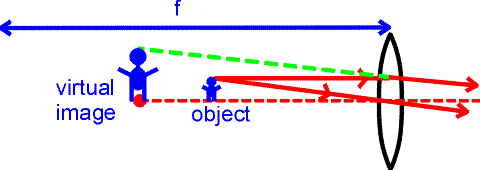

Far-sightedness
Far-sighted individuals are unable to focus on near objects. A normal near point is 25 cm, and if an individual's near point is beyond that, a converging (convex) lens must be used to modify light from an object at the normal near point to form an image at the individual's near point.

To solve for the required focal length to produce an image at the individual's near point, given that the object is at the normal near point,

The negative sign results from the fact that the image is behind the lens. By including an extra distance x (2.0 cm) for the distance between an individual's eye and glasses (not needed for contacts), the equation becomes,

A disquieting aspect of wearing converging lenses, is that if an object is placed outside the focal length, there is no virtual image on which to focus. However, a far-sighted person usually has sufficiently strong lens to compensate with the lens in their eye to focus the light as needed. Of course, especially with older individuals, sometimes a person can not focus on either near or far objects and bifocals are required.